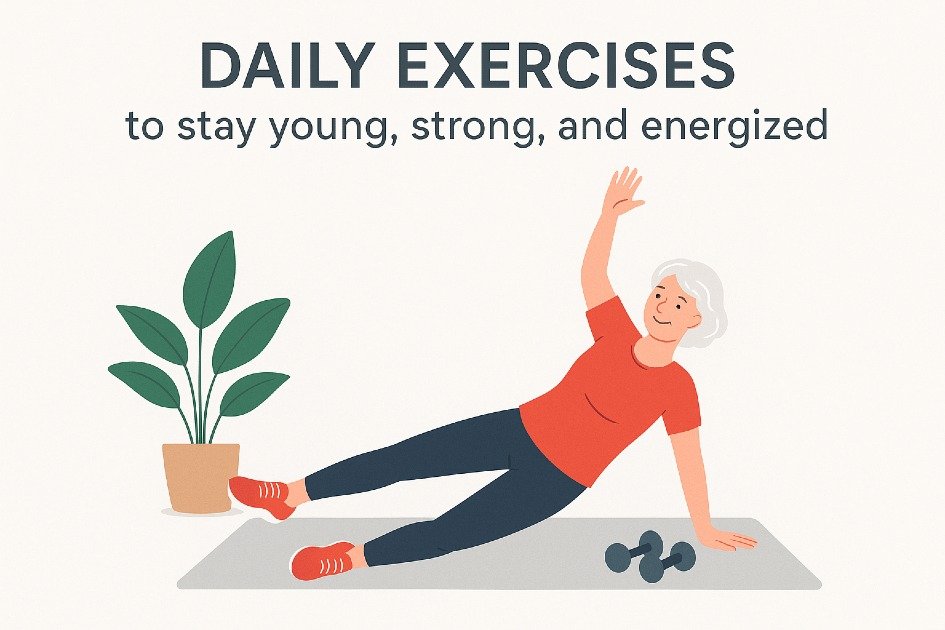Regular exercise at home can help maintain youthfulness and resilience without expensive gym memberships or fancy equipment.
Harvard Health found that individuals who exercised 150-300 minutes per week of moderate or vigorous exercise were 20% less likely to die during a study period.
Home workouts offer convenience, allowing for a mix of strength, cardio, and flexibility exercises. Even simple routines like stretching, bodyweight exercises, or light cardio can improve strength, longevity, balance, flexibility, and coordination.
Resistance bands or compact home gym tools can enhance workouts, and even a minimalist approach using only body weight can yield significant results when performed consistently and with proper technique.
This article offers practical tips for incorporating exercise into home life, from simple warm-ups to advanced routines, to promote a youthful, stronger, and resilient lifestyle, ensuring a transformative daily routine.
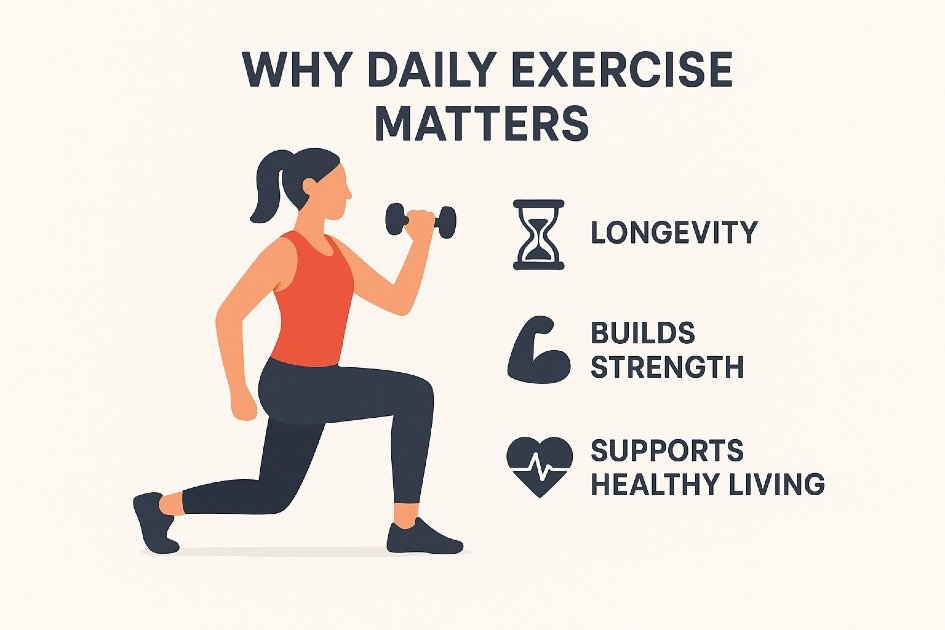
Why Daily Exercise Matters for Longevity and Strength
Daily exercise is crucial for maintaining youthfulness and vitality, as it enhances physical health, sharpens the mind, and strengthens the body.
How Consistent Movement Slows Aging
Regular exercise not only combats aging but also boosts energy levels by increasing the production of mitochondria in cells.
Movement leads to muscle shrinkage, stiffening joints, and slowing metabolism, accelerating both visible and invisible signs of aging.
To promote circulation and cell rejuvenation, commit to 20-30 minutes of daily movement, including brisk walks, home yoga, or light bodyweight exercises.
I started a 15-minute morning routine right in my living room. A mix of stretching and squats gave me more energy and helped me recover faster after busy days. Adding resistance bands brought a gentle strength challenge that also supports healthy aging.
The Connection Between Exercise and Mental Clarity
Sedentary lifestyles can cause brain fog, low energy, and poor focus. Exercise sharpens mind by increasing blood flow, promoting neuron growth, boosting memory, and regulating hormones.
Engage in short aerobic exercise bursts for 10 minutes to improve alertness and cognitive function and practice mindfulness for clarity.
When I skipped my morning workout, my mind felt slow. But after just 15 minutes of cardio, I became more alert, and my mood lifted right away.
Preventing Muscle Loss and Maintaining Bone Density
Inactivity weakens muscles and bones, increasingly falls and falls risk. Aging causes sarcopenia and bone density decline, requiring daily exercise to protect against these risks.
Strengthen your muscles with resistance training exercises like squats, push-ups, or light dumbbell routines, using household items like water bottles as effective tools.
I started doing three resistance workouts a week with bodyweight and light weights. After one month, I felt stronger standing up from chairs and my posture improved.
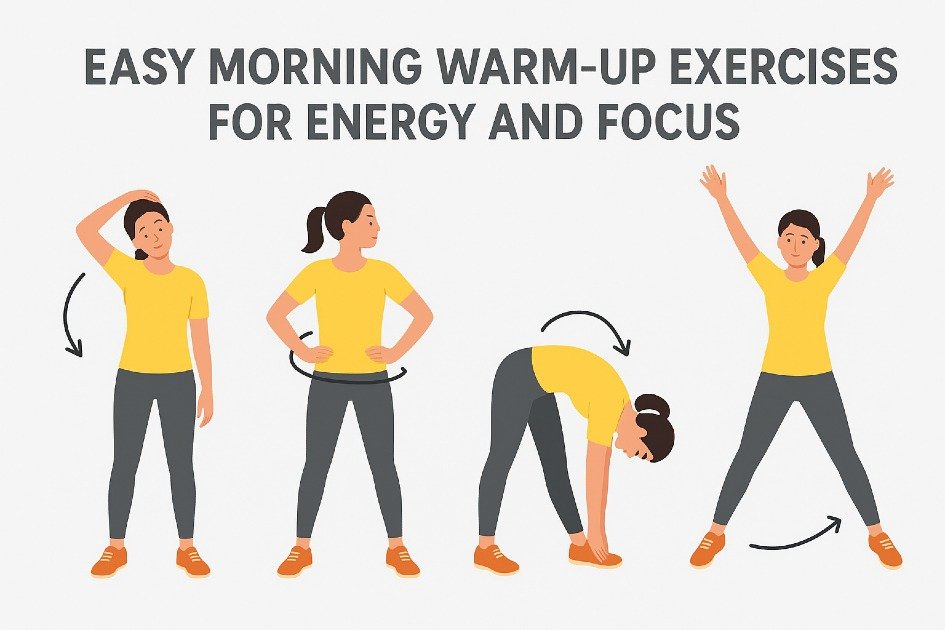
Simple Warm-Up Routines to Start Your Day Right
Warm-up sets energy, focus, and wellness; skipping it can cause muscle stiffness, joint tightness, injury risk, and hinder circulation.
Gentle Stretches to Wake Up Your Body
Why it matters:
Stretching improves blood flow to muscles, reduces morning stiffness, enhances range of motion, and enhances mood by releasing endorphins and reducing tension.
How to do it:
- Neck Rolls: Gently turn your head into a circle, five times each way.
- Shoulder Shrugs: Raise your shoulders to your ears, then lower them. Repeat ten times.
- Cat-Cow Stretch: Start on hands and knees. Slowly arch your back up, then round it down. Repeat 8–10 times.
- Side Stretches: Lift one arm overhead and lean toward the opposite side. Hold for 10 seconds on each side.
I move slowly and take deep breaths. A gentle stretch feels right; pain is a signal to stop.
Low-Impact Movements to Increase Circulation
Why it matters:
Circulation initiates metabolism and oxygenates muscles, while low-impact movements are gentle on joints and stimulate the cardiovascular system, preventing injuries during subsequent vigorous exercise.
How to do it:
- March in Place: Drive your knees up and pump your arms for 1–2 minutes.
- Arm Circles: Raise your arms to the sides and rotate them in small circles, then in large circles. Do ten reps each way.
- Heel Raises: Rise onto your toes and lower back down, 15–20 times to strengthen calves and boost balance.
- Torso Twists: Twist your upper body slowly from side to side while keeping your hips still. Do 10 reps.
I turn up my favorite tunes and move along—music makes my warm-up fun and full of energy.
Quick 5-Minute Warm-Ups for Busy Mornings
Why it matters:
Regular exercise prevents stiffness and improves posture, leading to long-term strength and flexibility gains. Consistent efforts create a habit loop, making daily exercise more manageable.
How to do it:
- Jumping Jacks or Step Jacks: Boost your heart in just 30–60 seconds.
- Dynamic Leg Swings: Step forward and sideways, ten times each leg to loosen your hips.
- Hip Circles: Place hands on hips and rotate your torso in slow circles, five times each way to activate your core.
- Wrist and Ankle Rotations: Rotate each joint ten times to warm up your arms and legs for daily activity.
Even when my schedule is packed, I use these quick steps to get my body and mind ready for tougher workouts.
Adding Mindful Breathing to Your Warm-Up
Why it matters:
Deep breathing improves oxygen delivery to muscles and brain, reduces stress hormones, and enhances exercise effectiveness by improving form and endurance.
How to do it:
- Inhale slowly through your nose for a count of four.
- Pause for 2 seconds.
- Breathe out gently through your mouth for six counts.
- Do 5–10 rounds of each stretch and gentle movement.
I pair deep breathing with gentle stretches to connect my mind and body, boosting the benefits of my exercise.
Creating a Consistent Warm-Up Habit
Why it matters:
Consistency in exercise leads to long-term improvements in strength, flexibility, and energy, reduces chronic pain and injuries, and builds momentum for daily exercise and healthy living.
How to do it:
- Wake up at the same time every morning, even if it is just for five minutes, to set a strong daily rhythm.
- Save a brief list of stretches and exercises on your phone or wall.
- Celebrate each completed routine to build lasting consistency.
- Slowly boost time or effort as your body gets stronger.
Even on busy mornings, a quick warm-up wakes me up, boosts my energy, and sets me up for a strong day.

Strength Training at Home: Build Muscle Without Weights
Strength training can be done at home, improving posture and metabolism without the need for gym equipment, requiring minimal equipment and delivering impressive results.
Bodyweight Squats: Power Up Your Lower Body
Why it matters:
Strengthens quads, hamstrings, and glutes for mobility and balance, enhances joint stability, reduces falls risk, and boosts metabolism for healthy weight maintenance.
How to do it:
- Place your feet shoulder-width apart, toes pointing slightly outward.
- Tighten your core and lower your hips like you are sitting in a chair.
- Point your knees toward your toes, lift your chest, and keep your back straight.
- Push through your heels to rise upright.
- Do three sets of 12–15 reps, slowly going deeper and faster with each set.
I hold a dumbbell or resistance band at my chest to make the exercise reach its maximum.
Push-Ups: Strengthen Your Upper Body Anywhere
Why it matters:
Strengthens chest, shoulder, and triceps muscles, improves functional movements, strengthens core, protects spine, and boosts upper body endurance without heavy equipment.
How to do it:
- Get into a plank with hands slightly wider than your shoulders.
- Bend your elbows to 45 degrees and slowly lower your body toward the floor.
- Lower yourself slowly, keeping your core tight.
- Try knee push-ups or incline push-ups on a solid surface to make the exercise easier.
- Try three sets of 10–15 reps, making it harder as you get stronger.
I use push-up sliders or mats with my push-ups to move smoothly and protect my joints.
Glute Bridges: Activate Core and Hips
Why it matters:
Strengthens glutes, lower back, and hamstrings, improves posture, reduces lower back pain, enhances hip mobility, supports walking and running mechanics, and counteracts long sitting hours.
How to do it:
- Lie on your back, bend your knees, and keep your feet flat on the floor.
- Squeeze your glutes and push your hips up toward the ceiling.
- Pause for 2–3 seconds, then lower slowly.
- Do three rounds of 12 to 20 repetitions.
I slide a resistance band just above my knees to make each move tougher and strengthen my legs more.
Plank Variations: Build a Rock-Solid Core
Why it matters:
Strengthens deep core muscles, improves stability, reduces injury risk, supports better posture, and enhances endurance for daily physical activities.
How to do it:
- Hold a forearm plank with elbows under shoulders, keeping your body straight.
- Activate your core, glutes, and legs.
- Stay in position for 20–60 seconds, slowly extending the time as you get stronger.
- Try side planks or plank-to-push-up moves to work different muscles.
I place a yoga mat under my elbows to protect them and stay comfortable.
Chair Dips: Sculpt Arms Without Gym Machines
Why it matters:
Strengthens triceps, shoulders, and chest, enhances arm definition and functional strength for daily tasks, and improves upper body endurance over time.
How to do it:
- Sit at the edge of a firm chair, holding the sides with your hands.
- Push your hips forward and bend your elbows to bring your body down.
- Lean your hips forward and bend your elbows to lower yourself. Press back up, keeping elbows tight to your body.
- Do three rounds of 10–12 repetitions.
I keep my feet close to the chair when starting out and stretch my legs forward when I want more challenge.
Step-Ups: Functional Strength for Legs and Balance
Why it matters:
Strengthens quads, glutes, and calves, improve balance, mimics natural movements like climbing stairs or stepping onto platforms, supports joint health and functional mobility.
How to do it:
- Step onto a solid surface, like a stair, bench, or platform.
- Push through your heel to lift your body onto the step with one foot.
- Lower yourself slowly, then switch to the other leg.
- Do twelve reps on each leg, repeat three times.
I hold light weights or water bottles to make my workout stronger without risking injury.
Cool Down and Stretch: Support Muscle Recovery
Why it matters:
This exercise promotes flexibility, prevents soreness, enhances circulation, reduces muscle stiffness, and encourages mindfulness and relaxation after exercise.
How to do it:
- Gently stretch all the muscles you use to improve flexibility and prevent soreness.
- Keep each stretch steady for 20–30 seconds. Avoid bouncing to protect your muscles.
- Breathe slowly and deeply, letting your muscles relax fully.
- Try using foam rollers or massage tools to help your muscles recover faster.
I hold light weights or water bottles to add safe resistance. I start small, stay in control, track my progress, and switch exercises to challenge different muscles and keep workouts fun.
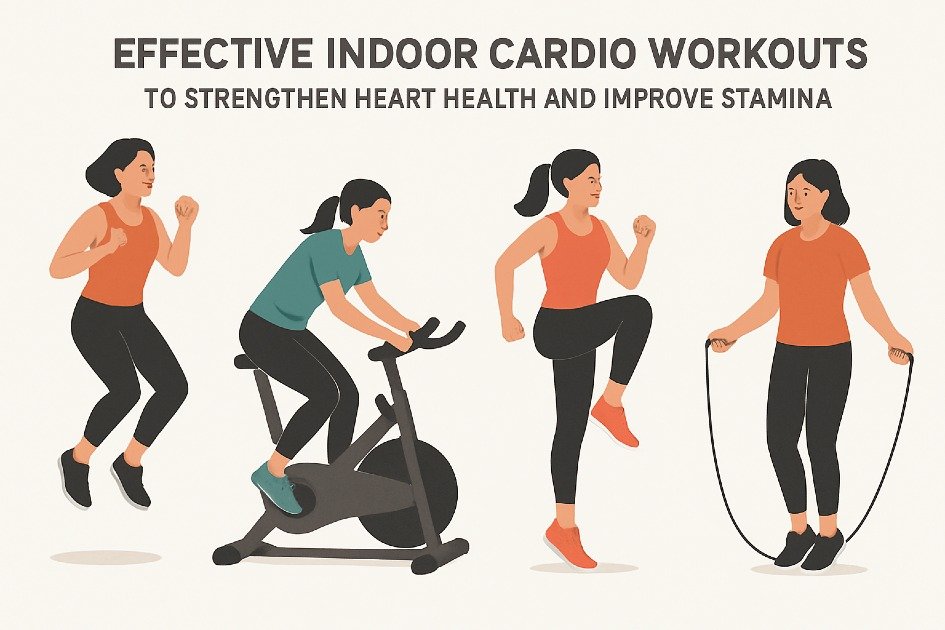
Cardio Workouts That Boost Heart Health Indoors
Maintaining a strong heart does not require gym memberships or outdoor activities; daily steps and cardio routines can boost stamina, energy, and overall health.
Why Indoor Cardio Matters for Heart Health
Why it matters:
Regular exercise is crucial for maintaining the strength of the heart, as it helps regulate blood pressure, boost circulation, and reduce stress without the need for weather or travel.
How to do it:
- Commit to at least 20–30 minutes of movement most days of the week.
- Try exercises that make your heartbeat faster but still let you talk easily.
Jumping Jacks: A Simple Start to Get Blood Pumping
Why it matters:
Jumping jacks are a cardio exercise that increases heart rate, improves oxygen flow, wakes up stiff muscles, and enhances coordination.
How to do it:
- Hold a tall posture with feet together and arms hanging gently at your sides.
- Hop up, stretch your legs apart, and swing your arms over your head.
- Go back to the start and do it again at a steady pace.
- Start with 30 seconds and increase time as your strength grows.
Marching or Jogging in Place: Low-Impact but Effective
Why it matters:
This exercise enhances leg strength, balance, and heart rate without straining joints, making it an excellent alternative to high-impact exercises.
How to do it:
- Lift your chest and pull your shoulders back to improve posture and boost confidence.
- Step in place, lifting your knees alternately.
- Move your arms naturally to boost workout intensity.
- For more challenge, jog lightly in place for 1–2 minutes.
High Knees: Boosting Stamina with Energy
Why it matters:
High knee exercises enhance endurance, core engagement, and fast calorie burning, resembling running but requiring minimal space.
How to do it:
- Place your feet hip-width apart and stand tall.
- Raise one knee to your chest, then switch.
- Swing your arms to drive your pace and boost energy.
- Try quick bursts of 20–30 seconds for top results.
Step-Ups Using a Sturdy Chair or Step
Why it matters:
Step-ups are a safe and effective exercise that strengthens legs and hips, supports mobility, and increases heart rate, making it suitable for beginners.
How to do it:
- Stand on a sturdy step or chair for balance and safety.
- Step forward with your right foot, then follow with your left.
- Lower yourself slowly, one foot at a time.
- Alternate your leading leg every 10–12 reps.
Dancing: A Joyful Way to Move
Why it matters:
Dancing is a fun activity that not only reduces stress, boosts mood, and keeps the heart active, but also delivers results without feeling like a workout.
How to do it:
- Play lively music that lifts your mood.
- Move your body freely, twist, or bounce.
- Try 3–4 songs to power a 10–15-minute cardio workout.
- Try faster beats to push your endurance.
Jump Rope: A Fun Way to Stay Fit
Why it matters:
Jump rope exercises enhance stamina, coordination, agility, and even improve rhythm, even if they are not physically performed.
How to do it:
- Grasp a rope or pretend you are holding one.
- Hop softly on your toes.
- Hold elbows close to your body and rotate your wrists smoothly.
- Try short bursts of 20–30 seconds to build strength and energy quickly.
Circuit Routine: Combine Moves for Lasting Energy
Why it matters:
Combining exercises prevent boredom, target multiple muscle groups, keeps the heart engaged, and mirrors real-life movements, making daily tasks easier.
How to do it:
- Do jumping jacks for 30 seconds to boost your heart rate and energy.
- March in place for 1 minute to boost circulation and energy.
- Do 20 seconds of fast high knees to boost your heart rate and burn calories.
- Do the circuit 3–4 times for a quick 15-minute cardio boost.
I do indoor cardio to keep my heart strong, lift my mood, and boost my energy. I start small, stay steady, and celebrate each step. With every beat, my heart thanks me.
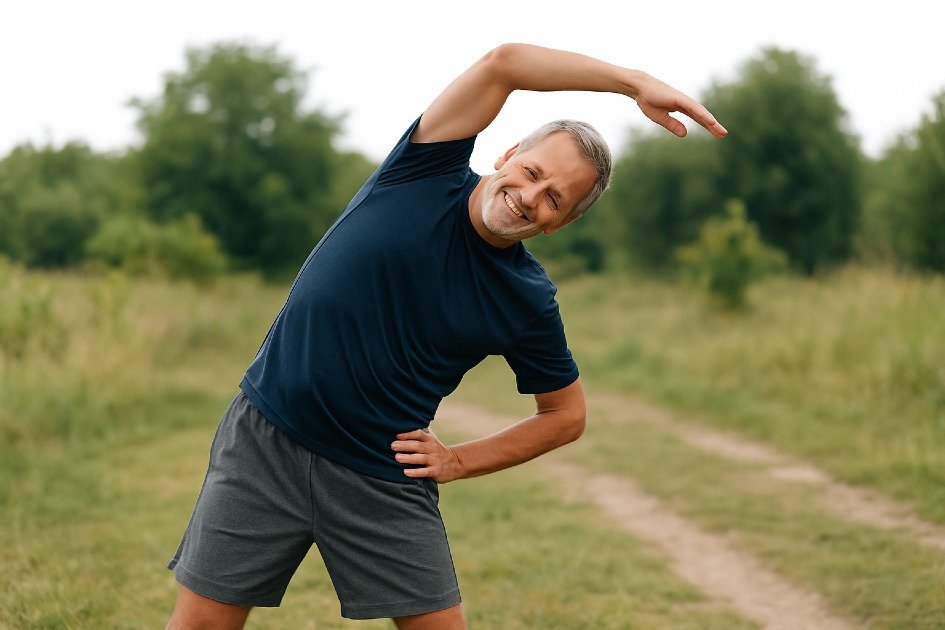
Flexibility and Mobility: Move Freely Every Day
Maintaining flexibility and mobility involves daily exercises that enhance joint health, reduce stiffness, and improve posture, preventing injuries, and keeping the body young and strong.
Why Everyone Needs Flexibility
Why it matters:
Regular flexibility exercises can improve muscle elasticity, making everyday tasks easier and safer, as aging can lead to tight muscles, limited range of motion, and chronic pain.
How to do it:
- Dynamic stretching: Gently stretch and move every part of your body. For example:
- Rotate your arms in small circles to loosen tight shoulders and improve mobility.
- Rotate your hips to warm up your lower body, improve mobility, and prevent injury.
- Static stretching: Stretch each muscle for 20–30 seconds to improve flexibility and prevent injury. Examples include:
- Floor Hamstring Stretch
- Wall Calf Stretch
I use a resistance band at home to make my stretches deeper and improve my flexibility.
Why Mobility Exercises Are Essential
Why it matters:
Mobility refers to the freedom of joints to move freely, which can enhance exercise performance, balance, and coordination, while reducing injury risk.
How to do it:
- Joint circles: Gently rotate wrists, ankles, and shoulders to keep them flexible and healthy
- Cat-Cow Pose: Round and arch your back to keep your spine flexible and strong.
- Hip openers: Perform lunges with a gentle torso twist to enhance hip flexibility
I started with small hip mobility drills each day and noticed my posture improved in just two weeks. I also added quick mobility moves between strength exercises to keep my joints active without pushing too hard.
Daily Yoga Moves to Increase Flexibility and Mobility
Why it matters:
Yoga enhances body fluid motion, prevents stiffness, and improves circulation, while also improving mental calmness and body awareness through short sessions.
How to do it:
- Downward Dog: Lengthens your hamstrings, calves, and spine for better flexibility.
- Child’s Pose: Eases tightness in the back and hips.
- Seated Spinal Twist: Boosts spine flexibility and supports digestion.
After my morning walk or evening workout, I spend 10 minutes stretching to build flexibility naturally.
Simple Home Tools to Boost Flexibility and Mobility
Why it matters:
Foam rollers, yoga blocks, and massage balls are small tools that target tight muscles and connective tissue, enhancing recovery and improving motion range, making exercise more effective and enjoyable.
How to do it:
- Foam rolling: Massage your calves, quads, and back for 30–60 seconds each.
- Yoga blocks: Use to lengthen stretches safely without risk of injury.
- Massage balls: Loosen your shoulders and feet to ease stress and boost circulation.
I keep foam rollers and a small mobility kit at home. I use them before or after workouts to boost recovery and get better results. They do not take much space and make training easier on my body.
Dailly Flexibility and Mobility Challenge
Why it matters:
Daily movement, even 10 minutes, leads to noticeable improvement over time, prevents stiffness, and prepares the body for more intense exercise.
How to do it:
- Try 2–3 stretches, or mobility moves each day to keep your body flexible and strong.
- Start a 5–10-minute timer and focus fully during that time.
- Add it to your morning or bedtime routine.
- Record your workouts in a journal or app to boost motivation and track growth.
I began with one simple hamstring stretch each night. After a month, I moved easier, squatted deeper, and lifted with less strain.
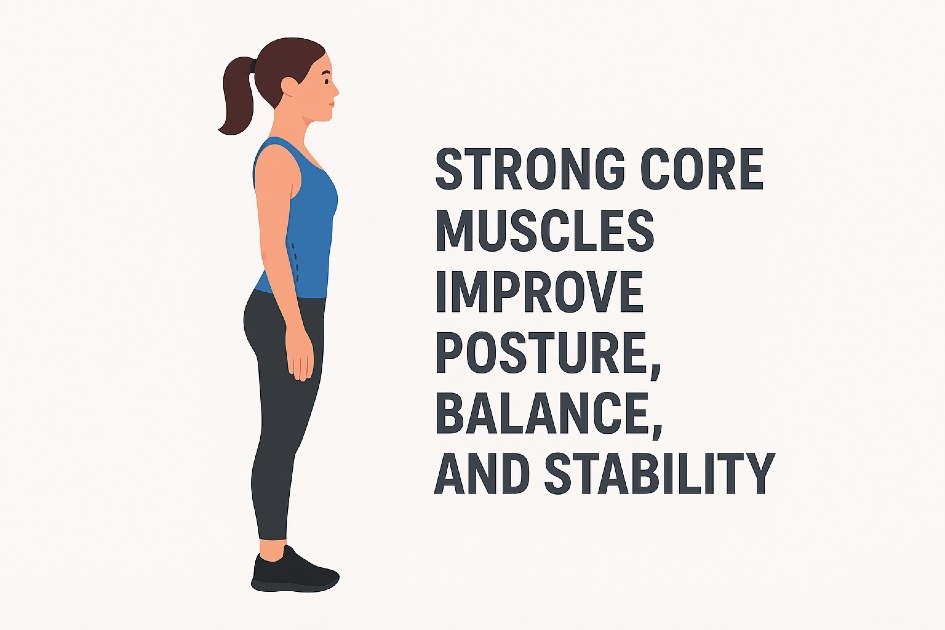
Core Strength: The Secret to Stability and Posture
Strengthening your core is crucial for maintaining balance, preventing injuries, improving posture, and feeling confident in daily movements. Practical exercises targeting your core are essential for overall health.
Plank Variations: Build Endurance and Stability
Why it matters:
Planks strengthen abdominal muscles, spinal stabilizers, and shoulders, improving posture, reducing back pain, and enhancing daily tasks like grocery lifting and reaching.
How to do it:
- Start in a forearm plank: keep elbows under shoulders and your body straight
- Hold the stretch for 20–30 seconds, then slowly work up to 1–2 minutes.
- Do side planks to work your obliques: raise one arm to the sky and keep your body straight.
I kept my breath steady, and my hips lifted. This stops me from slouching, makes my back muscles stronger, and improves my balance.
Dead Bug: Safe Core Activation for All Ages
Why it matters:
The Dead Bug promotes spinal alignment, deep core muscle activation, and improved coordination between arms and legs, reducing falls risk due to over-arching of the lower back during exercise.
How to do it:
- Lie on your back, lift your arms toward the ceiling, and bend your knees at a right angle.
- Lower your right arm and left leg toward the floor, keeping your lower back flat.
- Go back to the starting position and repeat on the other side.
- Do 10–12 reps on each side, keeping your movements slow and controlled.
I build a strong core without hurting my spine, making it easier to bend and reach in daily life.
Bird Dog: Enhance Balance and Spinal Integrity
Why it matters:
This exercise strengthens the posterior chain and abdominal muscles, improves balance, reduces lower back discomfort, and supports better posture while standing and walking.
How to do it:
- Begin on hands and knees, keeping shoulders above wrists and hips above knees.
- Extend your right arm straight ahead and stretch your left leg back, keeping your spine straight.
- Pause 3–5 seconds, then flip to the other side.
- Do ten reps on each side.
I keep my spine straight, build strong posture muscles, and move with better balance every day.
Russian Twists: Sculpt Obliques and Improve Core Rotation
Why it matters:
Rotational core strength is crucial for everyday movements like turning and twisting, while tones obliques support a slim, strong torso.
How to do it:
- Sit on the floor, bend your knees, lift your feet slightly, and lean back a little.
- Hold a light weight or clasp your hands and twist your torso side to side.
- Do 15–20 twists on each side.
- Move slowly and steadily—do not jerk.
I build my rotational strength, protect my back from strain, and move with better ease every day.
Glute Bridge: Core and Hip Power Combo
Why it matters:
The glutes and lower back stabilize the pelvis, while weak glutes can cause poor posture and lower back pain, while a strong posterior chain enhances walking, climbing, and standing posture.
How to do it:
- Lie on your back, bend your knees, and keep your feet hip-width apart.
- Lift your hips by pressing through your heels, keeping your shoulders, hips, and knees in a straight line.
- Tighten your glutes at the top, then lower with control
- Do 12–15 reps, pausing for 2 seconds at the peak of each move.
I build my lower back and glutes, ease pain from sitting, and keep my core strong.
Standing Core Exercises: Engage Muscles While Moving
Why it matters:
Standing core exercises enhance functional strength by mimicking daily movements and supporting posture while walking, bending, or carrying objects.
How to do it:
- Do side bends while holding a light resistance band. Strengthen your waist and improve core stability.
- Twist your torso side to side with arms stretched or holding a small household item.
- Keep your back straight and pull your belly button in toward your spine.
I keep my core tight during daily tasks to stay steady and protect my back. At home, I use a workout mat and resistance bands to make my exercises safe and effective.
Recap: Commit to a Daily Routine for Lasting Vitality
Daily exercise is not just about physical activity; it is about investing in your future self. Consistency is key to transforming effort into longevity.
Harvard Health suggests that enhancing performance involves connecting deeply with the goal’s importance, breaking it down into concrete steps, and tracking even small wins.
Regular exercise strengthens muscles, bones, minds, and moods. It also releases endorphins, reduces stress, and sharpens focus, keeping you young, confident, and unstoppable.
Home workouts are flexible, accessible, and adaptable to your lifestyle. To maximize results, pair your routines with smart tools like fitness trackers.
The journey to lasting vitality is personal, but everyone is never alone. Treat your body with intention and make daily exercise non-negotiable.
Start with short workouts, gradually build momentum, schedule reminders, mix strength, flexibility, and cardio, and track progress using a journal, trackers, or app.
Frequently Asked Questions
How often should I exercise to see noticeable results at home?
Daily exercise for 20-40 minutes can improve muscular tone, cardiovascular resilience, and joint flexibility. Even brief, structured sessions can yield significant improvements over weeks. For optimal results, combine exercise with proper hydration and nutrient-rich meals.
Can I build strength without any equipment?
Your body can be used as a versatile resistance machine for various exercises, including push-ups, squats, lunges, planks, and glute bridges, without the need for dumbbells.
What is the best time of day to exercise?
The optimal exercise time depends on individual rhythm and energy levels. Morning workouts boost metabolism, improve performance, relieve stress, and aid muscular recovery. Find your peak energy window and ensure adequate rest between sessions.
How do I prevent injuries while exercising alone?
To prevent strains, focus on proper form and gradually increase intensity. Use warm-ups, dynamic stretching, and mobility drills, and avoid sudden, high-impact movements. Use supportive mats and posture aids for joint protection. Listen to body signals.
Are short workouts effective for staying young and strong?
Micro-workouts, lasting 5-15 minutes, can improve cardiovascular health, muscular endurance, and flexibility. Intensity and consistency are key, and incorporating short, high-impact intervals or strength and balance routines can enhance performance.
How do I stay motivated to exercise daily?
Create a varied exercise routine, experiment with new techniques, and monitor your progress using tools like journals or apps to maintain positive habits.
Can older adults safely follow these routines?
Low-impact exercises for older adults promote balance, flexibility, and strength, reducing fall risk. Adjust intensity and consult a healthcare professional before starting. Gentle resistance bands or lightweight equipment can enhance safety.
What should I eat to complement my daily exercise?
Nutrition is crucial for recovery and performance, focusing on lean proteins, complex carbohydrates, healthy fats, and antioxidant-rich fruits and vegetables, and timing meals around exercise sessions.
How do I track improvement without fancy equipment?
Monitoring progress through indicators like strength, endurance, flexibility, and body composition, and using tools like journals, apps, or calendars, helps maintain accountability.
Are there exercises that improve both strength and flexibility simultaneously?
Functional movements like yoga, Pilates, and dynamic stretching circuits target strength and mobility simultaneously, engaging multiple muscle groups and enhancing flexibility and core stability, thus maintaining youthfulness and resilience.

